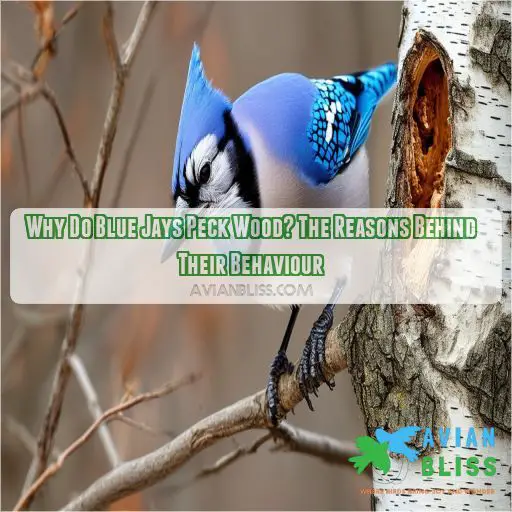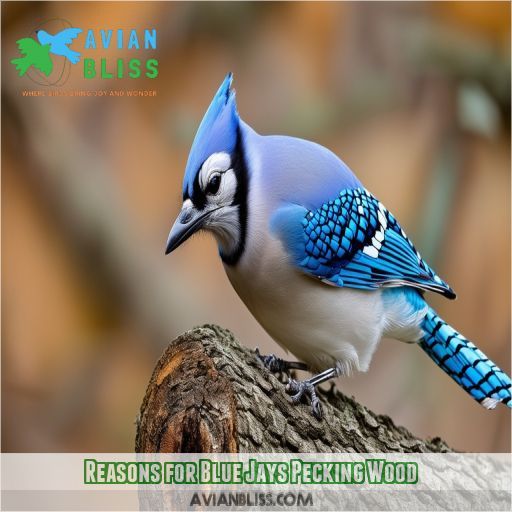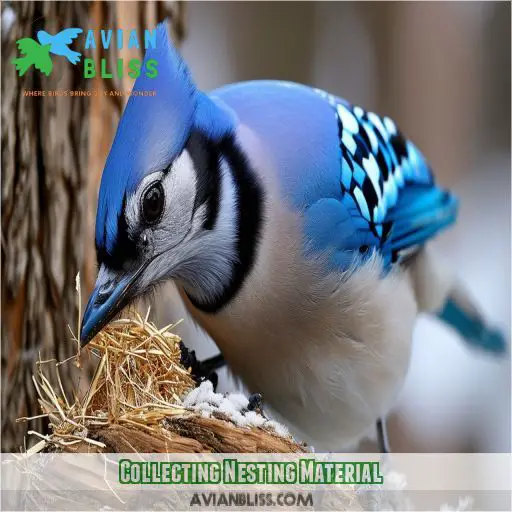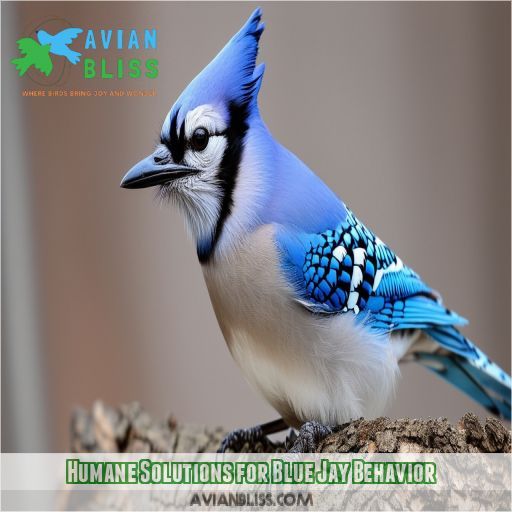This site is supported by our readers. We may earn a commission, at no cost to you, if you purchase through links.
 Woodpeckers are known for their wood-drilling abilities, but did you know that Blue Jays can also be culprits of this peculiar behaviour?
Woodpeckers are known for their wood-drilling abilities, but did you know that Blue Jays can also be culprits of this peculiar behaviour?
You may have noticed these colourful birds acting like woodpeckers, drilling holes in wood and causing damage. It’s not just a random act of curiosity; there are reasons behind their actions.
Read on to uncover the mysteries of why Blue Jays peck wood and the impact of their behaviour.
Table Of Contents
- Key Takeaways
- Why Do Blue Jays Peck Wood?
- Reasons for Blue Jays Pecking Wood
- Searching for Insects
- Collecting Nesting Material
- Territorial Behavior
- Impact of Pecking on Wood
- Preventing Blue Jays From Pecking
- Humane Solutions for Blue Jay Behavior
- Frequently Asked Questions (FAQs)
- Why are Blue Jays pecking at my house?
- Why do Blue Jays peck at windows?
- Are Blue Jays friendly to humans?
- Why do birds peck on wood?
- How do I stop blue jays from pecking my windows?
- Why do blue jays peck at my door?
- Do blue jays only peck wood for food?
- How can I provide alternative nesting areas?
- What are the signs of territorial behaviour?
- Conclusion
Key Takeaways
- Blue Jays might turn your deck into Swiss cheese because they are hungry and looking for a tasty snack.
- When it’s time to build a nest, Blue Jays diligently collect twigs, leaves, and even shiny objects, like coins.
- These birds are the self-appointed neighborhood watch of the avian world, always vigilant for intruders and ready to defend their territory with vigorous pecking.
- If the constant tap-tap-tapping tires you, redirect their attention humanely: offer alternative food sources or hang shiny, reflective tape.
Why Do Blue Jays Peck Wood?
Blue Jays are fascinating birds with a penchant for pecking wood, and understanding their behaviour can be intriguing. One reason for their wood-pecking is the search for food. These clever birds know that pecking can expose tasty insects and worms hiding beneath the surface. They also use this technique to collect and store nuts for the colder months, ensuring a steady food supply.
But it’s not just about food; Blue Jays also peck wood as part of their nesting behaviour. They carefully select locations, often opting for the safety of oak trees, and then build intricate nests using a variety of materials. There’s more to explore about these beautiful birds and their habits.
Reasons for Blue Jays Pecking Wood
Blue jays may peck wood for a variety of reasons, including searching for food sources or collecting nesting material. Understanding these underlying motivations can help you effectively redirect their behavior and prevent damage to your property.
Food Sources
One reason why blue jays peck wood is to find food. They peck at trees to attract insects, which they then eat. Blue jays also use their beaks to expose worms hiding in the soil or under bark. In addition to insects, blue jays also collect and store nuts, like acorns, for future consumption.
Here are three reasons why blue jays peck wood for food:
- Exposing worms and insects
- Collecting and storing nuts
- Attracting insects to the surface
Nesting Behaviour
Blue jays are known for their nesting behavior, which involves the construction of intricate nests using various materials, including wood. The location of their nests is carefully chosen, often in oak trees or other tall structures, as they prefer to build their homes in elevated locations.
The diet of blue jays also plays a role in their nesting behavior. These birds are known to feed their nestlings a variety of insects and small animals, ensuring the healthy development of their young.
In addition to their diet and nest construction, blue jays are also territorial birds. They’ll aggressively defend their nesting sites and territory, engaging in disputes with other birds or animals that venture too close.
Redirecting Blue Jays
If blue jays are causing trouble around your home, there are a few ways to redirect them to alternative locations:
- Offer nesting boxes or birdhouses at forest edges or wooded lots, providing them with a new home away from your deck.
- Use reflective tape or motion-activated sprinklers as deterrents to encourage blue jays to seek out other areas.
- Try placing bird feeders or bird baths in your yard to offer an appealing alternative food source or bathing spot, drawing them away from your deck.
Searching for Insects
Blue jays are curious and explorative birds with a penchant for pecking.
This curiosity may lead them to your deck if they suspect it harbors insects, a tasty treat.
These intelligent birds possess the ability to learn from experience, forming associations between certain sounds or textures and a good meal.
Unfortunately, their pecking can cause significant structural damage to your deck, so it is important to take action early on.
Collecting Nesting Material
Now that we’ve explored the possibility of blue jays pecking wood in search of insects, let’s turn our attention to another common reason for this behavior: the collection of nesting materials.
When it comes to building their nests, blue jays exhibit remarkable ingenuity and resourcefulness. They carefully select materials that will provide comfort, security, and camouflage for their young. Here are some key considerations they make when choosing nesting materials:
- Nest Location: Blue jays often build their nests in deciduous trees, taking advantage of the dense foliage to conceal their nests from predators. They prefer locations that offer a good vantage point, allowing them to keep a watchful eye on their surroundings.
- Nesting Materials: These birds are known for their creativity in using a variety of materials. They may collect twigs, leaves, grass, moss, and even human-made items like string, paper, or fabric scraps. Blue jays have been observed stealing shiny objects like jewelry or coins, perhaps mistaking them for valuable nesting materials.
- Nest Size and Design: Blue jays construct cup-shaped nests, ensuring a snug and secure space for their eggs and hatchlings. They pay close attention to the size and depth of the nest, ensuring it’s just right for their needs. The nests are often lined with softer materials like animal hair, feathers, or plant down, creating a cozy environment for the developing chicks.
Territorial Behavior
Blue jays are known for their territorial behavior, which can lead to pecking wood as a way to mark their territory. This behavior is often driven by a desire to protect their nesting sites and assert dominance over other birds.
| Reason | Description |
|---|---|
| Territorial Disputes | Pecking wood can be a way for blue jays to establish and defend their territory, especially during mating season. |
| Mating Rituals | Male blue jays may peck wood to attract potential mates, demonstrating their strength and fitness. |
| Dominance Battles | Pecking behavior may also be a way for blue jays to establish a pecking order within their flock, determining access to resources and mates. |
Impact of Pecking on Wood
The impact of blue jay pecking on wood is significant, and this behavior can result in substantial damage to structures, creating a problem for homeowners.
If left unchecked, it can lead to safety hazards and cause a disturbance for nearby residents due to the noise created.
Thus, it is essential to address this issue promptly and effectively to minimize any potential harm to both the birds and property.
Preventing Blue Jays From Pecking
To prevent blue jays from pecking your deck, start by covering vulnerable areas with mesh or sealants, making the wood less attractive. Providing alternative food sources and seeking professional assistance can further protect your deck and redirect the birds’ behavior.
Covering Vulnerable Areas
Blue Jays can be persistent when pecking, and covering vulnerable areas is an important step in preventing further damage. Here are some options to explore:
- Sealant Options: Use wood fillers or sealants to cover holes and cracks. This deters the birds from further pecking and also helps to maintain the structural integrity of the wood.
- Mesh Alternatives: For larger holes, consider using wire mesh as a physical barrier. This method allows you to cover the vulnerable area while still maintaining the aesthetics of the wood.
- Repair Methods: If the damage is extensive, you may need to replace or repair the affected wood. This could involve sanding and refinishing the area to create a smooth surface that’s less appealing to the birds.
Providing Alternative Food Sources
If you’re dealing with pesky blue jays that keep pecking at your deck, you might want to contemplate offering them some alternative food sources.
This could be a win-win situation: the birds get a tasty treat, and you get your deck back, intact and hole-free.
Try setting up bird feeders with a variety of bird seeds.
Experiment with different foods and storage methods to find the most effective combination that keeps the birds happy and your deck peck-free!
Professional Assistance
If the problem persists, contact a wildlife rehabilitator or pest control company for professional assistance. They can provide expert advice and help implement safe and humane solutions to deter blue jays from pecking your deck. Remember, it’s important to act quickly to prevent further damage and guarantee the safety of both your property and these curious birds.
Humane Solutions for Blue Jay Behavior
Now that you know how to prevent blue jays from pecking your deck, it’s important to explore some humane solutions to address their behaviour. Remember, blue jays are protected by law in many areas, so harming or killing them isn’t an option. Here are some safe and effective strategies to think about:
Firstly, you can use safe deterrents like reflective tape or motion-activated sprinklers. These methods startle the birds without causing them any harm and can be especially effective at night when the tape reflects light. You could also try providing alternative nesting areas, such as birdhouses or nesting boxes placed a safe distance away. This might redirect their nesting behaviour and satisfy their need for a safe space. Another strategy is food redirection, where you offer alternative food sources, like a feeder, farther from your deck. This may divert their attention and hunger, reducing the impact on your property.
If temporary containment is necessary, perhaps for relocation, you can use humane traps designed to safely capture birds. These traps won’t harm the blue jays. For expert advice, contact a wildlife rehabilitation centre or pest control company. They can guide you on humane solutions, ensuring the well-being of both the birds and your property.
Frequently Asked Questions (FAQs)
Why are Blue Jays pecking at my house?
Blue Jays peck at houses for several reasons, including searching for insects, chipping paint for calcium, communicating with other birds, or excavating the external layers of wood.
Why do Blue Jays peck at windows?
Why are these birds knocking on your window? Blue Jays may be attacking their own reflection, defending their turf from a rival bird. To stop this, place a non-reflective screen outside the window or add decals or film to the window.
Are Blue Jays friendly to humans?
Blue Jays are curious, clever, and unafraid of humans. They can learn to trust people and may even follow you around. They’re protective and get close to humans, sometimes even landing on balconies to ask for treats.
Why do birds peck on wood?
Pecking on wood is a common behavior among woodpeckers, who use their beaks to search for food, create nesting cavities, and communicate with other birds. They may also be maintaining their bills, marking territory, or engaging in social interaction.
How do I stop blue jays from pecking my windows?
To stop blue jays from pecking your windows, use decals, screens, or films to reduce reflectiveness. Also, try visual deterrents like scarecrows, owl decoys, or hanging CDs. Position bird feeders away from windows and avoid shiny objects in your garden.
Why do blue jays peck at my door?
Blue Jays peck at doors for several reasons, including:
- Gaining calcium from paint
- Communicating with other birds
- Scaring other birds
- Marking their territory
Do blue jays only peck wood for food?
No, Blue Jays peck wood for various reasons, including to feed on insects, mark their territory, clean their bills, or remove paint chips for nutrition.
How can I provide alternative nesting areas?
To provide alternative nesting areas, plant native deciduous trees, such as oak, maple, and birch, which offer sturdy branches and ample foliage for protection and concealment. You can also plant coniferous trees, like pine and spruce, for additional security.
What are the signs of territorial behaviour?
Blue jays are known for their territorial behaviour, often defending their territory and kin through vocal displays and physical confrontations. They’re protective of their nests and food sources, chasing away smaller species from bird feeders and baths.
Conclusion
There you have it—the mystery of why Blue Jays peck wood is No more. It’s a combination of their foraging instincts, nesting habits, and territorial behaviour. With this knowledge, you can now take action to either prevent or redirect their pecking behaviour, depending on your preferences and the situation.










